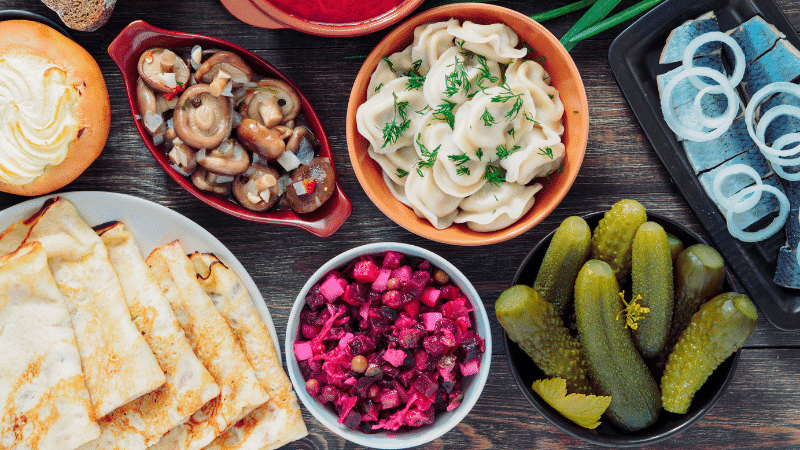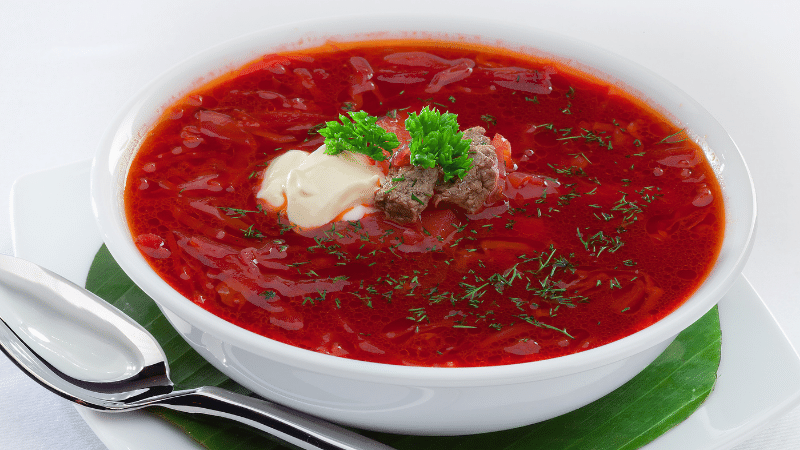The flavors of Russia are as diverse and unique as its people. The country is home to some genuinely mouth-watering dishes with a mixture of Russian, European, Asian, and Middle Eastern influences. Russian cuisine can be described with one word: hearty. The average meal will consist of meat, potatoes or rice, vegetables like cabbage or celery, sour cream or yogurt for dipping bread into at the end of your meal. From soups and stews to sweet desserts that will melt in your mouth – there’s so much flavor waiting for you.
So, if you’re a foodie, Russia is the right place for you. With so many different flavors and dishes to try, it’s hard not to have a good time while you taste your way through the country. This blog post will walk you through the most popular Russian foods and flavors that this vast country has to offer. But, first, let’s take a closer look at some of the most popular flavors in Russia.
A Short History Of Russian Food

The history of Russian food and cooking is a long and complex one. The cuisine is diverse, with the country’s vast expanses giving rise to different climates and cultures. Both Eastern European and Asian cuisines influenced Russian cuisine. It has been shaped by many factors, including (but not limited to) climate, geography, history, culture, and economic status.
Russian food today has been influenced by both Eastern European and Western European cooking styles. In the 18th century, Catherine II introduced French cuisine to Russia but was quickly replaced by German cuisine during World War I. The Soviet Union also significantly influenced Russian food, with dishes like borscht being created for the masses.
The Most Common Russian Flavors
Sour (Кислый)
In Russian culture, sour and pickled foods are a sign of hospitality. Sour food is often served as an appetizer or a side dish to accompany other dishes. The most popular sour foods in Russia are probably pickled cucumbers, followed by pickled cabbage and mushrooms, which come in many shapes and sizes. Pickled foods are usually eaten with bread before breakfast, lunch, or anytime before the main course. Sour cream is another common supplementary component in many traditional Russian dishes.
Example sentence: The pickles are sour. (Соленья кислые.)
Sweet (Сладкий)
Russians are known for their love of sour foods, but they also have a sweet tooth. The most popular desserts in Russian cuisine are pirozhki, bliny, and syrniki. Pirozhki are stuffed with meat or potatoes and onions, while blini are thin pancakes made from yeast batter that can be served savory or sweet with toppings like caviar or jam. Syrniki are fried cheese balls traditionally eaten during Lent to break the fast.
Example sentence: The ice cream is sweet. (Мороженое сладкое)
Salty (Соленый)
Russian love their dough and carbs-rich food, spiced by pickles and a lot of salt. Bread and salt are pretty much considered the national foods of the Russian people. The Russian word for salt is соль, and they even have a soup called solyanka, which got its name because of the amount of salt that it contains.
Example sentence: I love salty food. (я люблю соленую пищу.)
Spicy (Пряный)
Spicy food in Russia includes dishes like borscht, a beet soup usually served cold and has a hot or mild broth. It also includes pickled mushrooms or cucumbers, cabbage rolls stuffed with meat and rice, shrimp cocktail sauce, traditionally eaten as an appetizer. It’s not uncommon to see Russians eating pickles with chili sauce or drinking vodka mixed with pepper and horseradish.
Example sentence: Spicy food is healthy. (Острая пища полезна.)
Bitter (Горький)
Bitter foods are something that Russians have grown accustomed to over time- so much so that they’ve come up with some pretty creative ways to use this particular flavor. One such drink is kvass, a fermented rye bread beverage that can be enjoyed hot or cold. Kvass is full of probiotics that are good for your gut health, and it’s made with either water or milk and sugar. Another example is erofeich, a traditional bitter herbal liqueur, which first appeared at the beginning of the 18th century. It’s usually combined with high-fat foods to promote digestion.
Example sentence: The coffee is bitter. (Кофе горький.)
The Most Popular Russian Dishes

Russia is a country with many different flavors to offer. Russia has it all from the tundra of Siberia to the subtropical Black Sea coast. From the spicy and hearty soups to the sweet desserts, it’s easy to see why Russia has become such an iconic cuisine. The Russian diet is typically comprised of lots of meat dishes, but there are also plenty of vegetarian options for those who prefer not to eat animal products.
The cuisine in Russia varies depending on which region you are visiting. For example, in Moscow, there are foods like traditional Russian dishes – borsch and pelmeni, which stay fairly consistent throughout the country, but each region has its unique flair. However, go further into rural areas like Siberia or Kaliningrad. You will find some less common dishes such as stroganina (raw beef/beef stroganoff) and kulich (a type of bread).
Traditional Russian cuisine has not changed much since tsarist times in rural Russia. The most common foods are bread, potatoes, cabbage soup, and kasha (buckwheat porridge). There are also many different types of bread: rye bread with caraway seeds, black bread made from wheat, and rye flour mixed. The traditional breakfast in Russia usually consists of black bread or rye bread accompanied by tea or coffee.
Common Words Related To Food And Flavors
| English | Russian |
| boiled eggs | вареные яйца |
| cold soup | холодный суп |
| served hot | подается горячим |
| side dish | гарнир |
| bitter | горький |
| spicy | пряный |
| sour | кислый |
| sweet | сладкий |
| salty | соленый |
| salad | салат |
| salted fish | соленая рыба |
| mashed potatoes | пюре |
| pickled cabbage | квашеная капуста |
| fish soup | рыбный суп |
| minced meat | мясной фарш |
Learn Russian With Ling App
The Ling app by Simya Solutions is an app that provides a personalized approach to learning over 60 languages for free in a gamified environment. You can learn on your own time, at any pace, with lessons tailored to you. The app includes lesson content in more than two dozen languages, including Russian. Ling App’s goal is to make language learning accessible for everyone by allowing learners to practice their skills through games.
In addition to that, if you enjoyed this article and you’d like to learn more about Russian people and their traditions, make sure to check out our Russian blog and read articles like how to greet the locals once you travel to the country.
Wait no more, get the app and let’s improve your Russian together! Happy learning!











